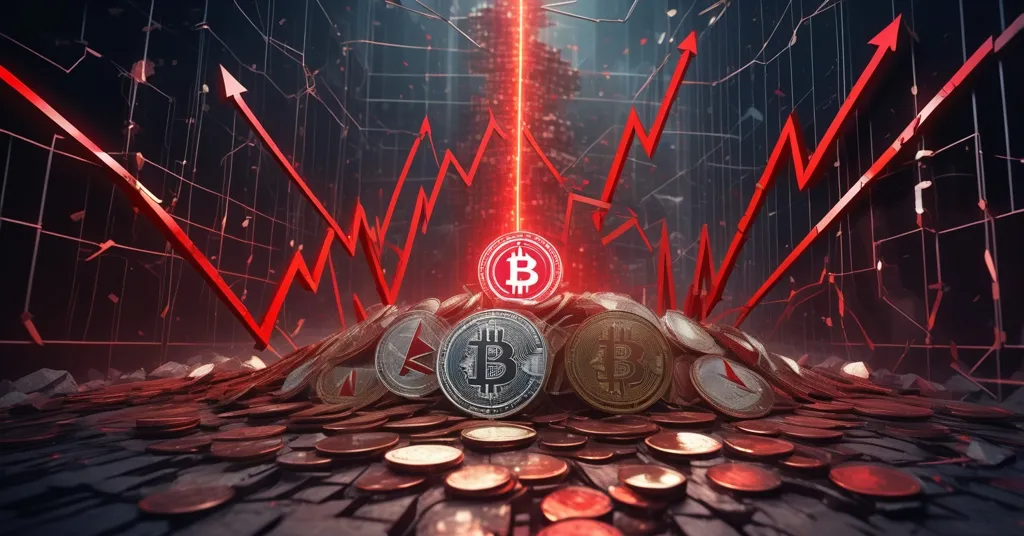October Crypto Crash Shatters VC Easy Money, B2 Ventures Signals Infrastructure Shift

October Crypto Market Crash Ends Easy VC Money, Warns B2 Ventures
October’s crypto market crash, a savage event that obliterated $19 billion in liquidations, has slammed the brakes on the era of reckless venture capital (VC) funding in the crypto space. In a candid interview with Arthur Azizov, founder of B2 Ventures, we get a raw look at how this bloodbath is forcing VCs to ditch speculative gambles and focus on rock-solid infrastructure—a shift that could redefine the future of Bitcoin, blockchain, and beyond.
- Brutal Wake-Up: October’s $19 billion liquidation crash has VCs obsessing over risk like never before.
- New Priorities: Forget flashy tokens; VCs are now chasing crypto infrastructure to weather the storms.
- Tougher Market: Larger funds rule the game as the space matures, leaving weak projects in the dust.
- Macro Shadows: Monetary policy and global tensions are now key drivers in VC decisions.
The October Bloodbath: A VC Reckoning
The crypto market took a gut punch in October, with a staggering $19 billion wiped out in liquidations across major exchanges like Binance and Bybit. Bitcoin and Ethereum bore the brunt of the carnage, as over-leveraged traders were mercilessly wiped out in a matter of hours. This wasn’t just another dip; it was a glaring signal that the market’s wild west days are numbered. Arthur Azizov of B2 Ventures didn’t hold back when describing the aftermath in a recent discussion on the crypto crash.
“Undeniably, the October flash crash was a wake-up call for the market. From what I’ve observed, the immediate reaction from most institutional investors was a sharp increase in risk scrutiny — the quality of collateral, liquidity sources, and the mechanics of liquidations, let alone leverage,”
he said. Translation? Big players are no longer playing fast and loose. They’re dissecting every deal, questioning how liquidations unfold, what backs a position, and just how much leverage is too much. For retail traders who got rekt, it’s a harsh lesson; for institutional investors, it’s a call to tighten every screw.
This isn’t just about cleaning up a mess—it’s about preventing the next one. The crash exposed vulnerabilities in how collateral (assets backing trades) is valued and how liquidity (available cash or assets to trade) is managed during sudden drops. For those new to the game, liquidations happen when a trader’s position loses too much value to cover their borrowed funds, forcing exchanges to sell off their holdings at a loss. When this cascades across millions of accounts, as it did in October, markets spiral. VCs are now on high alert, and the freewheeling cash splash of 2021 feels like ancient history.
Where Smart Money’s Heading Now
So, where’s the money flowing in this post-crash reality? Azizov is crystal clear on the pivot.
“The most forward-looking VCs are moving beyond narratives and switching their attention from ‘crypto products’ to ‘crypto infrastructure.’ I expect this trend will continue to define 2026,”
he noted. No more dumping millions into the latest meme coin or DeFi project promising absurd returns. Remember when Dogecoin was a VC darling? Now it’s barely a blip as investors hunt for projects with real meat on the bones. The focus is shifting to the plumbing of the crypto world—think middleware that bridges blockchain protocols for seamless asset flow, or data tools that help predict and dodge disasters. For the uninitiated, middleware is like the translator between different blockchain languages, ensuring Ethereum talks to Solana without a hitch. Risk intelligence platforms, meanwhile, are like weather forecasts for market storms, giving investors a heads-up on potential wipeouts.
Tokenized real-world assets (RWAs) are another hot ticket. These are everyday assets—think real estate, art, or bonds—turned into digital tokens on a blockchain, allowing fractional ownership and easy trading. Imagine owning a tiny slice of a Manhattan skyscraper via a token on Ethereum; platforms like Harbor are already making this a reality and catching VC eyes. Then there’s market-neutral yield strategies, which aim to make money whether prices soar or tank. Picture it as balancing your portfolio so you’re not screwed by a Bitcoin crash—in crypto, this might mean arbitrage (exploiting price differences across exchanges) or staking assets for steady returns. Azizov’s filter for funding is brutal and straight-up.
“My filter is simple: ‘Will this project still matter if the market gets rough?’ If the answer is ‘yes,’ and the team can deliver, it’s worth backing. Everything else is just noise,”
he declared. No sugarcoating here—VCs are done bankrolling vaporware and hype machines.
Market Growing Pains
The crypto space isn’t just shifting focus; it’s growing some damn teeth. Azizov highlighted a stark trend of consolidation among investors.
“I find this consolidation to be the result of natural market evolution. It’s tempting to call it just ‘risk aversion,’ but in reality, it reflects a maturing market,”
he explained. Big, battle-tested funds are now dominating deal flow, while smaller players or startups with flimsy ideas are getting laughed out of the room. Imagine pitching a flashy token in 2021 and walking away with millions—today, without a rock-solid revenue plan, you’re toast. This isn’t mere caution; it’s a higher bar for entry. Only the fittest survive, and if you’re rooting for innovation, that’s not a bad thing.
But here’s a flip side worth chewing on: are VCs playing it too safe? Some argue that obsessing over infrastructure stifles the chaotic creativity that birthed DeFi and NFTs in the first place. Overemphasizing nuts and bolts could choke out the next big idea—a risky token that might just redefine finance. Sure, we’ve seen plenty of scams, but isn’t crypto’s wild spirit part of its DNA? This tension between stability and experimentation is something to watch as the market evolves.
Under-the-Radar Drivers: Perpetual Futures
One area Azizov flagged as criminally overlooked is perpetual futures, a type of derivative contract that lets traders bet on Bitcoin’s future price without an expiration date. Unlike traditional futures that close on a set day, these are a never-ending wager as long as you cover the margin costs (funds to keep the position open). They’re massive, accounting for over 68% of Bitcoin derivatives trading volume. Why care? Because they’re a linchpin for risk transfer—big players like hedge funds use them to hedge bets or speculate without owning the underlying asset. This is a key step toward institutional adoption, making crypto less of a gamble and more of a serious financial tool.
But there’s a dark edge. Perpetuals can turbocharge crashes when over-leveraged traders get caught in a squeeze. In October, cascading liquidations in these contracts amplified the $19 billion wipeout as positions unraveled en masse. It’s a double-edged sword: vital for market maturity, but a ticking bomb if not managed. The broader crowd often fixates on spot prices while ignoring this behind-the-scenes beast—VCs, however, are taking note as a cornerstone of the ecosystem.
Macro Forces and Beyond
Crypto isn’t an island anymore; it’s tangled up in the messy web of global finance. Azizov pointed out how macro factors are now front and center for VCs.
“Higher rates have made investors more selective, switching attention from ‘growth at any cost’ to clear business models and sustainable unit economics,”
he said. Breaking that down, “unit economics” is just how a project makes money per user or transaction—can it turn a profit without burning cash? When central banks hike interest rates, borrowing gets pricier, and VCs stop funding moonshots. Add in geopolitical trade tensions—like U.S.-China spats over tech—or real yields (returns adjusted for inflation), and you’ve got a recipe for pickier investors. They’re hunting projects with real revenue and teams that can pivot when the world gets dicey.
Zooming out, crypto VCs aren’t the only ones chasing transformative tech. In Q2 2025, five U.S. AI startups each raised over $1 billion, with AI deals grabbing 35.6% of deal count and nearly two-thirds of VC value stateside. Crypto isn’t seeing that cash tsunami yet, but there’s overlap on the horizon. Think decentralized data markets where AI models run on blockchain networks like Ethereum, or tokenized AI assets traded on-chain. VCs might soon bridge these worlds, funding hybrids that blend artificial intelligence with distributed ledgers—a space to watch.
What’s Next for Crypto Funding?
Let’s not kid ourselves: the end of easy VC money spells pain for many crypto startups. The party’s over, and only projects with real utility and adaptable teams will snag the cash. But there’s a bright side to this reckoning. Tighter funding could choke out the endless parade of rug pulls and Ponzi schemes posing as “innovative DeFi.” As a Bitcoin maximalist, I can’t help but smirk at altcoin casinos crumbling under their own hype. Yet, fairness demands a nod to Ethereum’s smart contracts and Solana’s speed—they fill gaps Bitcoin doesn’t touch, like complex DeFi or rapid transactions. Bitcoin remains the gold standard for decentralization and store of value, especially in crashes where its resilience often outshines volatile alts. The balance is key: champion freedom and privacy via BTC while letting other chains innovate in their niches.
Looking to 2026, this VC shift might turbocharge projects that push decentralization and privacy—core tenets of why we’re here. Imagine funding for zero-knowledge proofs (tech hiding transaction details while proving validity) or fully decentralized exchanges that can’t be censored. This aligns with effective accelerationism—pushing tech forward responsibly to disrupt the status quo. The road will be rough, and not every startup will survive the scrutiny. But if this builds a tougher, more resilient ecosystem, I say bring on the purge. We’re here to accelerate a financial revolution, not babysit scams or hype cycles.
Key Takeaways and Burning Questions
- What did the October crypto market crash reveal about VC priorities?
It laid bare the urgent need for risk scrutiny, shoving VCs away from speculative bets toward infrastructure that can endure brutal volatility. - Which emerging trends are VCs betting on in the crypto space?
Tokenized real-world assets, market-neutral yield strategies, and risk intelligence tools are stealing the spotlight for their long-term staying power. - How is the crypto market’s maturation reshaping funding?
Big funds are taking over deal flow, jacking up standards and leaving half-baked projects scrambling for scraps. - Why should perpetual futures matter to Bitcoin traders and investors?
They dominate derivatives volume at over 68%, acting as a critical tool for risk management and a gateway to institutional adoption. - Are macroeconomic factors really crucial to crypto VCs?
Damn right—monetary policy, real yields, and geopolitical tensions now shape deal flow, forcing a focus on sustainable models over reckless growth. - Could this VC crackdown clean up crypto’s bad rap?
Possibly—stricter funding might starve out scams and rug pulls, letting legit projects focused on decentralization shine brighter. - Where does Bitcoin fit in this post-crash VC landscape?
As the bedrock of decentralization, Bitcoin’s resilience in crashes keeps it central, though altcoins like Ethereum carve out vital niches VCs can’t ignore.



